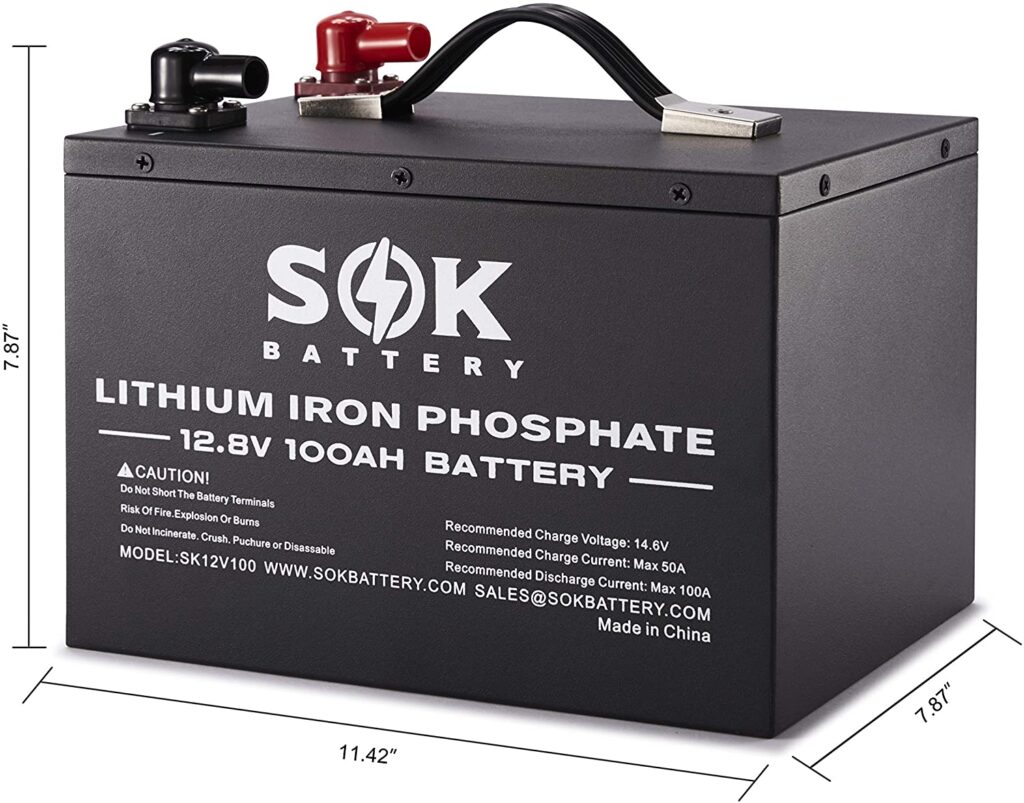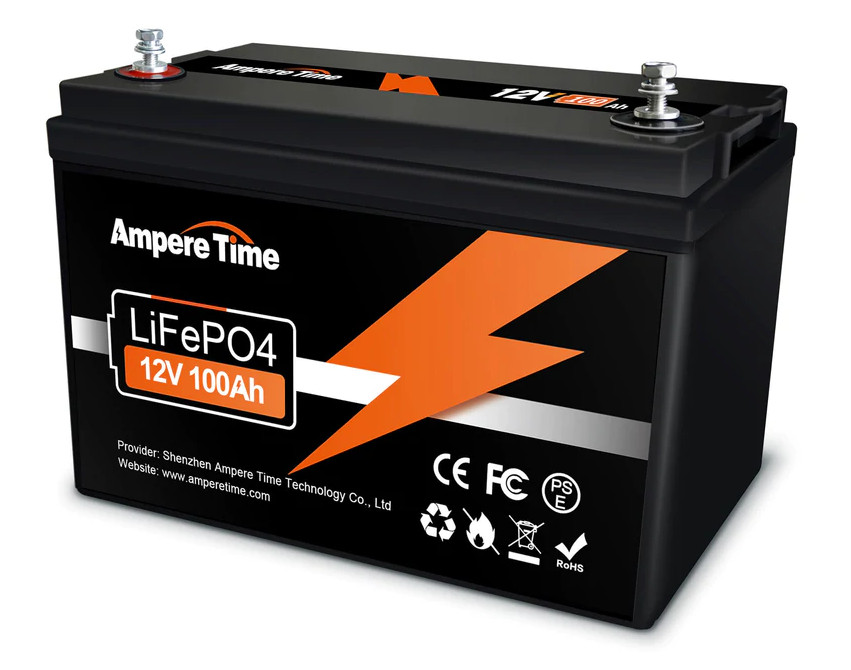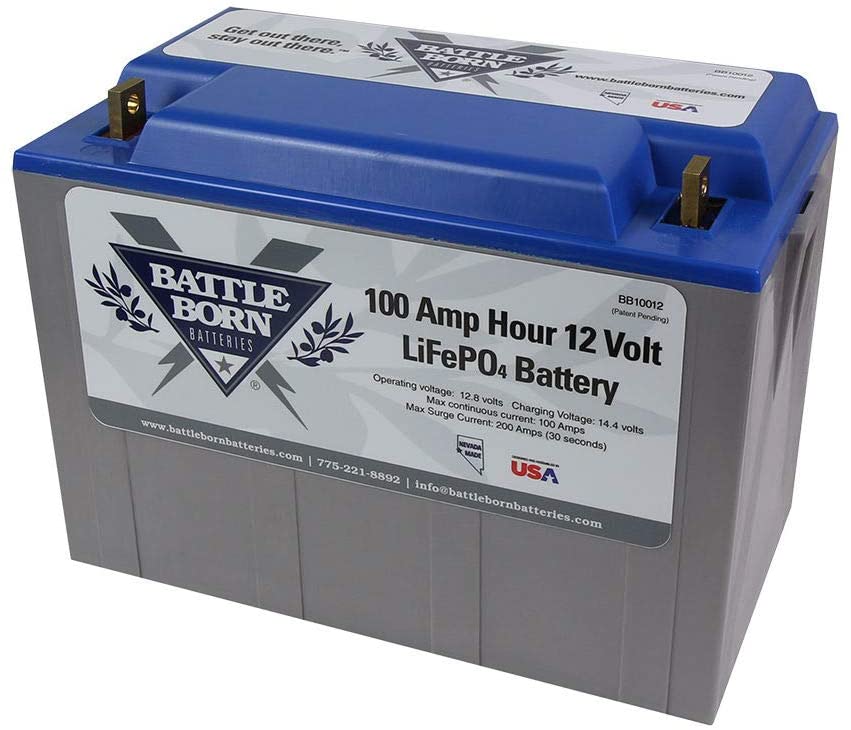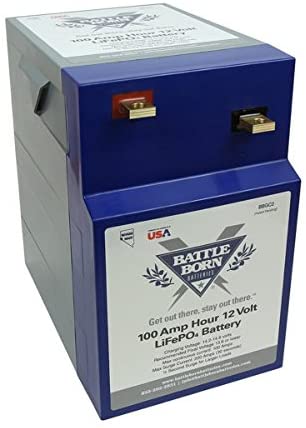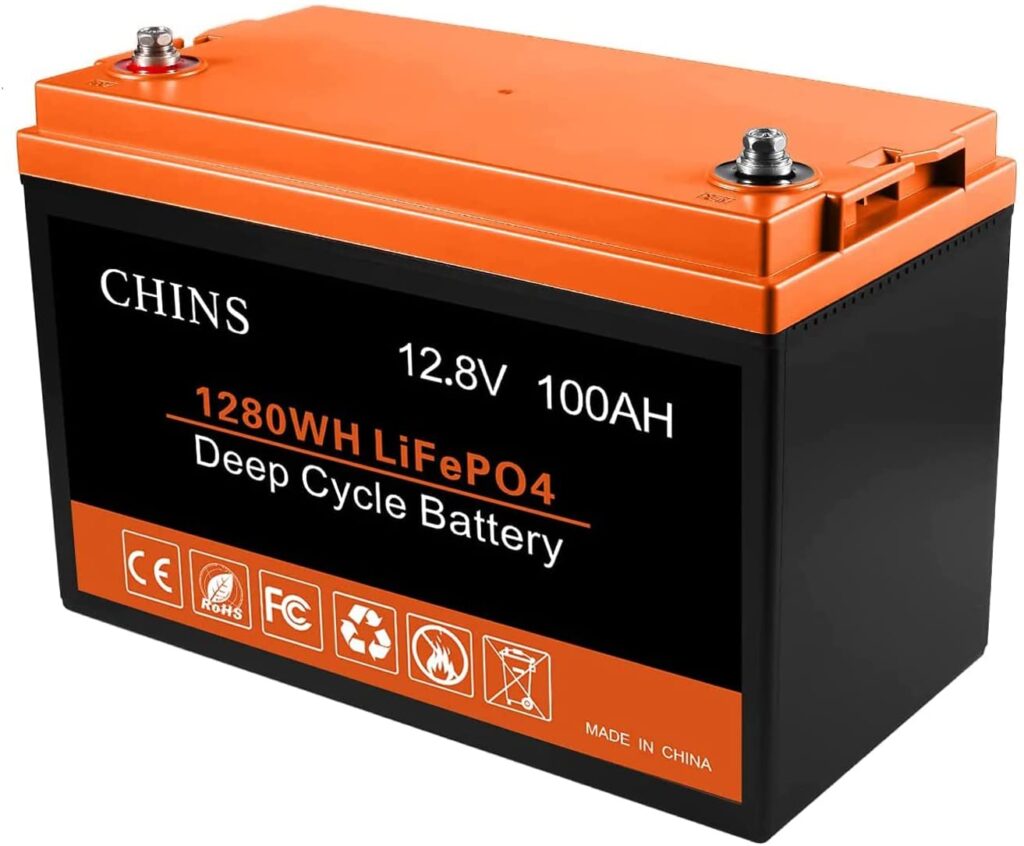Lithium iron phosphate (LiFePO4, Li = Lithium, Fe = Iron, PO4 = Phosphate) batteries have an extremely high life-cycle, often taking 1,000 to 10,000 cycles before reducing to 80% of their original capacity. They are also drop in replacements for lead acid batteries, meaning you can simply replace a traditional lead acid battery with one of these without having to change any of the electronics of the system. The high life-cycle and capacity retention of LiFePO4 batteries make them great for solar power use where they may experience a daily charge and discharge cycle. For example, a battery that experiences 5,000 charge/discharge cycles (at once per day), would last over 13 years!
It’s common to connect multiple batteries together to create a battery bank with a higher power capacity. A solar charge controller is also often used to charge the battery bank from solar panels and invert the direct current voltage (DCV) of the batteries (typically 12, 24, or 48 DCV) to the higher alternating current voltage (ACV) to power household devices (typically 120 or 240 ACV).
Features to look for in a LiFePO4 battery
If you’re not building your own battery from scratch, then there are a few features to look for in a consumer-ready LiFePO4 battery to determine its quality. These are a solid set of features to look for when choosing a battery unless your specific application dictates otherwise.
- Battery Management System
A battery management system (BMS) handles protecting the battery cells during charging and discharging. There are often additional features to a BMS, such as the ability to specify specific charging and discharging parameters, Bluetooth connectivity to connect with your phone to monitor the battery and configure settings, and more. Therefore, a quality BSM is an essential part of a consumer LiFePO4 battery. - High and Low Temperature Disconnect
This is a feature of the BMS that manages charging and discharging the cells. If the temperature is too high or low when charging, the battery cells can be destroyed. The high and low temperature disconnect will prevent charging when temperatures are too high or low. - Over Current and Short Circuit Protection
This is a feature of the BMS that monitors the power draw of the devices connected to the battery. If too much power is drawn or a short circuit is created, the cells can be damaged or worse, the cells can leak or explode, causing a toxic chemical or fire hazard. If over current or a short circuit is detected, the BMS will disconnect the the cells to protect them from damage. - Adequate Power Lugs
The lugs on the battery that you connect bus bars or wire to are an important part to consider. There may be very high currents passing through this point and the lugs should be sufficiently sized for the current load it’s likely to experience. Also worth considering is how the lugs are configured, whether they are threaded to accept a bolt or have a hole to provide your own nut/bolt, and the of the size bolt (which determines what size crimp lug) that can be accommodated.
Best Value
SOK Lithium Iron Phosphate Batteries
SOK produces well-built batteries with a quality BMS and case that can be disassembled to service the internal components. With the features these batteries provide, you would expect them to be priced several hundred dollars more. These are listed first because these provide the best bang for your buck (unless you build your battery from scratch).
SOK LiFePO4 (12 Volt, 100 Ah)
- 12V LiFePO4 Deep Cycle Lithium Iron Phosphate Battery
- 100 Ah Capacity
- 28 lb weight
- 11.42 in x 7.87 in x 7.87 in (L x W x H)
- Built-in Battery Management System (BMS)
- 4000~8000 cycle life & Maintenance-free
- High & low temperature protection/disconnect
- Over charge & over discharge protection
- Over current & short circuit protection
- All metal case (most are plastic)
- Detachable cover, user serviceable BMS and cells
Ampere Time
After SOK, Ampere Time LiFePO4 batteries are the next best value, in terms of cost, reliability, and quality.
Ampere Time LiFePO4 (12 Volt, 100 Ah)
- 12V LiFePO4 Deep Cycle Lithium Iron Phosphate Battery
- 100 Ah Capacity
- 24.25 lb weight
- 13 in x 6.82 in x 8.48 inches in (L x W x H)
- Built-in Battery Management System (BMS)
- 4000~8000 cycle life & Maintenance-free
- High & low temperature protection/disconnect
- Over charge & over discharge protection
- Over current & short circuit protection
- Detachable cover, user serviceable BMS and cells
Other Models
Ampere Time LiFePO4 12 Volt, 200 Ah
Ampere Time LiFePO4 12 Volt, 300 Ah
Ampere Time LiFePO4 12 Volt, 400 Ah
Ampere Time LiFePO4 24 Volt, 100 Ah
Ampere Time LiFePO4 24 Volt, 200 Ah
Ampere Time LiFePO4 48 Volt, 100 Ah
Best Quality
Battle Born Lithium Iron Phosphate Batteries
Battle Born batteries are considered the gold standard in quality and reliability. They consistently outperform other batteries in reliability and durability. They are marine grade, meaning they are sealed and designed to handle the most abusive marine environment, exposed to high humidity and vibration. You’ll pay a bit more per battery, but you can expect these batteries to handle whatever you throw at them.
Battle Born LiFePO4 (12 Volt, 100 Ah)
Battle Born LiFePO4 (24 Volt, 50 Ah)
- 12V and 24V LiFePO4 Deep Cycle Lithium Iron Phosphate Battery
- 50 Amp hour or 100 Amp hour capacity
- 31 lb (12 V) and 29 lb (24V) weight
- 12.75 in x 6.875 in x 9 in (L x W x H)
- Marine Grade
- Built-in Battery Management System (BMS)
- 3000-5000 charge cycles
- High & low temperature protection/disconnect
- Over charge & over discharge protection
- Over current & short circuit protection
- 100 amp continuous output (200 amp surge output)
- 1200 watt hours total capacity (1280 watt hours usable)
- Lithium Iron Phosphate Chemistry (safest choice for mobile solar power systems)
- Drop-in Lead Acid Replacement (works with any 12v or 24v solar charge controller, but be sure to select the “LiFePO4” or “sealed lead acid” charge setting)
- This battery can be series connected (you can use it to build 12/24/48 volt systems)
Battle Born GC2 LiFePO4 (12 Volt, 100 Ah)
Same stats as the 100 Amp hour 12-volt model above, but can be more easily connected in parallel with bus bars. If you have a large battery bank and plan to use bus bars to connect all your batteries, this is a great option.
Best Price
Chins Lithium Iron Phosphate Batteries
Chins batteries are the next best to SOK batteries, with the only real difference being they do not provide low temperature charging protection. If your batteries will not experience low temperatures (freezing), high vibration, or a marine environment, you can save a lot by buying these batteries instead of SOK or Battle Born. Some solar charge controllers can provide low temperature charging protection if your batteries are stored in the vicinity of the charge controller’s temperature probe.
Chins LiFePO4 (12 Volt, 100 Ah)
Chins LiFePO4 (12 Volt, 200 Ah)
Chins LiFePO4 (12 Volt, 300 Ah)
Chins LiFePO4 (12 Volt, 400 Ah)
Chins LiFePO4 (24 Volt, 100 Ah)
Chins LiFePO4 (24 Volt, 200 Ah)
- 12V and 24V LiFePO4 Deep Cycle Lithium Iron Phosphate Battery
- 100 to 400 Amp hour capacity
- Built-in Battery Management System (BMS)
- High temperature protection/disconnect
- No low temperature protection/disconnect
- Over charge & over discharge protection
- Over current & short circuit protection
LiFePO4 Cells
Bare LiFePO4 lithium battery cells are the individual cells found within battery packs. These can be used to build your own DIY battery pack in conjunction with a battery management system to manage the pack.
3.2 Volt Cell: 100 Ah, 200 Amp Discharge
- Minimum Capacity: 100 Amp-hour
- Continuous Discharge Current: 200 Amp (2 C)
- Standard Charge Current: 50 Amp (0.5 C)
- Heavy duty threaded stud terminals
- It is very important to use a BMS to manage these cells!
- Discounts: 10% discount on 8+ cells, 12% discount on 16+ cells
